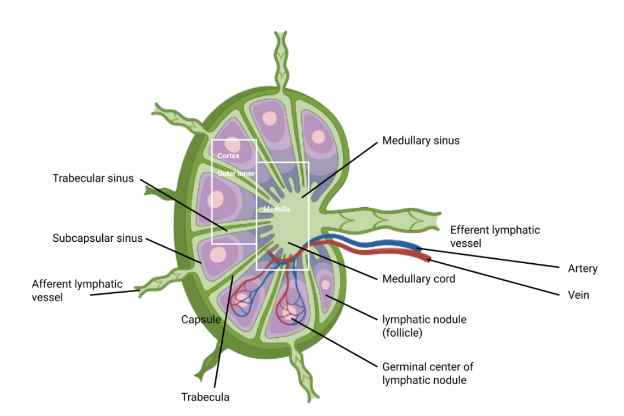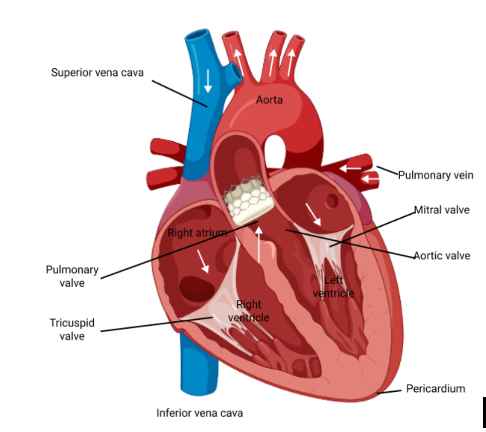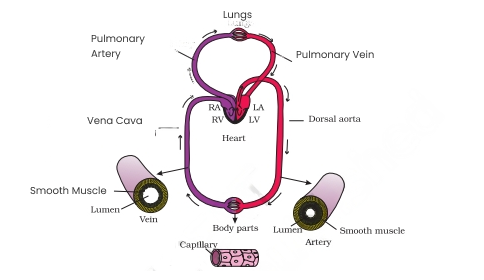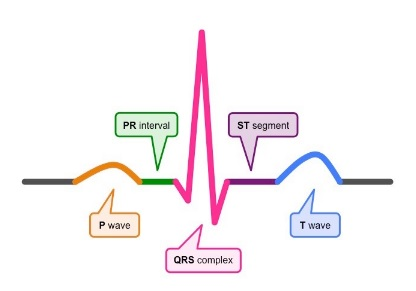Biology Notes for Chapter 15 Body Fluids And Circulation Class 11 - FREE PDF Download
FAQs on Body Fluids And Circulation Class 11 Biology Chapter 15 CBSE Notes - 2025-26
1. How can I quickly revise the main components of blood and their functions from this chapter?
For a quick recap, think of blood in two parts. First is plasma, the fluid part, which transports nutrients, hormones, and waste. The second part is the formed elements, which include:
- Erythrocytes (RBCs): Carry oxygen.
- Leukocytes (WBCs): Fight infections.
- Thrombocytes (Platelets): Help in blood clotting.
2. What is the easiest way to remember the steps of blood coagulation for a quick revision?
To simplify the coagulation process for revision, remember this sequence: An injury activates platelets and releases certain factors. This triggers a cascade of reactions involving clotting factors, converting inactive prothrombin into active thrombin. Thrombin then converts soluble fibrinogen into insoluble fibrin threads, which form a mesh-like clot to stop the bleeding.
3. For revision, what are the key differences between open and closed circulatory systems I should focus on?
The main difference to remember is how blood flows. In an open circulatory system, blood is pumped into a body cavity called the haemocoel, directly bathing the tissues. In a closed circulatory system, blood is always contained within vessels (arteries, veins, capillaries) and never comes in direct contact with body cells. The closed system allows for more efficient and rapid blood flow.
4. How does the concept of double circulation explain why the human heart is so efficient?
Double circulation means blood passes through the heart twice for each complete circuit of the body. One path is the pulmonary circulation (to the lungs to get oxygen), and the other is the systemic circulation (to the rest of the body to deliver that oxygen). This separation keeps oxygenated and deoxygenated blood from mixing, ensuring that the body's tissues receive blood with the highest possible oxygen concentration, making the entire system highly efficient.
5. What do the P, QRS, and T waves in an ECG represent? I need a simple summary for my notes.
For a quick summary of an ECG, remember these key points:
- The P-wave represents the electrical excitation (or contraction) of the atria.
- The QRS complex represents the contraction of the ventricles.
- The T-wave represents the return of the ventricles to their normal, relaxed state (repolarisation).
6. Why is understanding the Rh factor more critical than just ABO blood groups during pregnancy?
The Rh factor is crucial because of a condition called erythroblastosis fetalis. If an Rh-negative mother carries an Rh-positive foetus, her body may produce antibodies against the foetus's Rh-positive blood. While the first pregnancy is usually safe, these antibodies can cross the placenta in subsequent pregnancies and destroy the foetal red blood cells, causing severe anaemia or even death. This specific risk is not associated with ABO group mismatches.
7. What are the main disorders of the circulatory system mentioned in the NCERT syllabus that I must include in my revision notes?
When revising this chapter, make sure your notes cover these key circulatory disorders:
- Hypertension: High blood pressure.
- Coronary Artery Disease (CAD): Also known as atherosclerosis, where arteries supplying the heart become narrowed.
- Angina: Chest pain due to insufficient oxygen reaching the heart muscle.
- Heart Failure: When the heart doesn't pump blood effectively enough to meet the body's needs.
8. How does the lymphatic system work alongside the main circulatory system? What's the connection I should remember for revision?
The key connection to remember is that the lymphatic system is a parallel system that helps the main circulatory system. As blood flows through capillaries, some fluid leaks out into the tissues. The lymphatic system collects this excess fluid, now called lymph, and returns it to the bloodstream. It also plays a vital role in immunity by filtering pathogens through lymph nodes. Think of it as a drainage and defence partner to the blood circulatory system.
9. Beyond just pumping blood, what is the fundamental role of the cardiac cycle in maintaining overall body function?
The cardiac cycle is more than just a pump; it's a precisely timed sequence that ensures continuous and efficient blood flow. This cycle creates the pressure gradients necessary to push oxygenated blood to all tissues and return deoxygenated blood to the lungs. This continuous supply of oxygen and nutrients, and removal of waste, is essential for every cell to function, produce energy, and maintain homeostasis, which is the stable internal environment of the body.
10. When revising Body Fluids and Circulation, which diagrams are most important to practice for a better understanding?
For effective revision of this chapter, focus on practicing these three main diagrams:
- The structure of the human heart, showing all four chambers, major blood vessels, and valves.
- A standard ECG (Electrocardiogram), labelling the P, QRS, and T waves.
- The schematic representation of double circulation, showing both pulmonary and systemic circuits.































